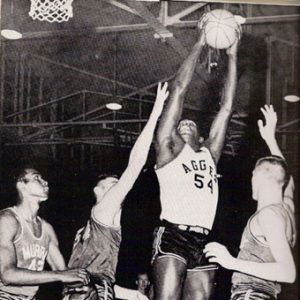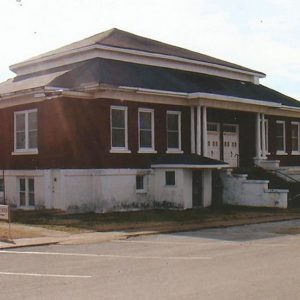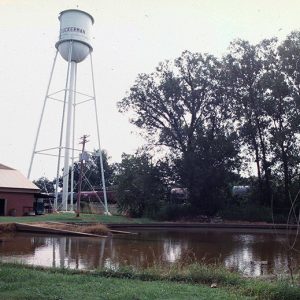calsfoundation@cals.org
Tuckerman (Jackson County)
| Latitude and Longitude: | 35°43’50″N 091°11’54″W |
| Elevation: | 233 feet |
| Area: | 2.68 square miles (2020 Census) |
| Population: | 1,707 (2020 Census) |
| Incorporation Date: | November 18, 1891 |
Historical Population as per the U.S. Census:
|
1810 |
1820 |
1830 |
1840 |
1850 |
1860 |
1870 |
1880 |
1890 |
1900 |
|
– |
– |
– |
– |
– |
– |
– |
– |
– |
260 |
|
1910 |
1920 |
1930 |
1940 |
1950 |
1960 |
1970 |
1980 |
1990 |
2000 |
|
583 |
778 |
938 |
875 |
1,253 |
1,539 |
1,731 |
2,078 |
2,020 |
1,757 |
|
2010 |
2020 |
|
|
|
|
|
|
|
|
|
1,862 |
1,707 |
|
|
|
|
|
|
|
|
Situated on higher land several miles east of the Black River, Tuckerman was bypassed by the construction of the four-lane Highway 67 in 2009. Charming, well-preserved older houses still line the old highway, which was designated “Rock ’n’ Roll Highway” by the Arkansas state legislature that same year because of the many star performers who honed their skills in the small towns up and down this road—performers including Elvis Presley, Johnny Cash, Sonny Burgess, Conway Twitty, and many more.
When European explorers and settlers first came to Arkansas, the north shore of the White River was included in land claimed by the Osage as hunting grounds, although they lived farther north in what would become the state of Missouri. When treaties removed the Osage from this land, settlers began to develop it for farming, principally of cotton. As late as the Civil War, the primary communities of Jackson County were Jacksonport and Grand Glaise on the White River, both the sites of significant Civil War engagements in the area.
The building of the Cairo and Fulton Railroad—later the St. Louis, Iron Mountain and Southern Railroad, until it was acquired by the Missouri Pacific Railroad—led to the establishment of Tuckerman as well as various other cities in northeast Arkansas. Tuckerman was named for a railroad executive who seems to have made no other notable contributions to the railway industry or the history of Arkansas. The establishment of the train depot attracted several settlers, including brothers D. C. Dowell and F. R. Dowell in 1878, followed by Frank Harrison and a Dr. Richardson, as well as an African-American family by the name of Lucas. A post office was established on September 2, 1874, and the first postmaster was Thomas Richardson. Early businesses in the new city included a store operated by Alex Lockard, a business remembered as “Bloom’s Store,” and a Masonic lodge. The first church in the city was a Methodist church, which began in 1884 but did not receive its first pastor (S. D. Evans) until 1887. A Baptist church called Pleasant Grove No. 2 was founded in 1894. Its first pastor was S. W. Abernathy, and it was affiliated with the Spring River Baptist Alliance. Its name was changed to First Baptist Church when it acquired property in town in 1903, but it relocated again in 1911, moving from the east side of town to the west. In 1915, it affiliated with the Black River Baptist Association. The timber industry also provided jobs in the area for some time.
Tuckerman was incorporated on November 18, 1891, indicating that it had already gained a significant population. The Bank of Tuckerman opened in 1902, with J. A. Lindley as the first bank president. Other businesses were established, including the J. L. Parrott store and several stores operated by the Graham brothers. The first school, a white frame building with two rooms, was replaced in 1907 with a two-story structure of red brick. Additions to the school were added in 1918. A Church of Christ was established in 1921.
The city, which relied primarily on the railroad and area agriculture, was hit hard by the Depression. Tuckerman’s one structure on the National Register of Historic Places is the water tower that was built with Public Works Administration (PWA) funds in 1935. During this time of Jim Crow laws, the African-American citizens of Tuckerman lived east of the railroad tracks and had their own schools, churches, and businesses, while the white citizens generally lived west of the tracks. African-American men worked for the railroad and in the cotton gins, as well as on various farms, while African-American women often were employed as maids. The school district desegregated in 1967.
The Red Brick School burned down in January 1944. A larger building was constructed, and several rural school districts were consolidated into the Tuckerman school district. Highway 67 was built through Tuckerman on a line parallel to the railroad tracks. New businesses were established along the highway to serve travelers, as well as the local population. These included the restaurants and clubs where early rock and roll performers developed the acts that would make them internationally famous. Act 497 of 2009 commemorates this era in its designation of Rock ‘n’ Roll Highway through this stretch of the state.
Tuckerman has also made its mark on contemporary athletics. It was the hometown of basketball star Jim “Bad News” Barnes, who was an outstanding student athlete at Texas Western College (now the University of Texas at El Paso) in 1964 and was also a member of the United States 1964 Olympic basketball team before playing for five National Basketball Association (NBA) teams in a seven-season career. Since 2007, Tuckerman has been home to the Valiant Arena of the All-Star Wrestling Federation, founded in Walnut Ridge (Lawrence County) in 1999 by Aaron Polston and Leonard Doan.
Tuckerman has been damaged by tornadoes several times over the years, most recently in 1999. A large tornado passed through the area on May 15, 1968, killing thirty-five people and injuring 364.
By 2009, Tuckerman Elementary School had 350 students through grade six, and Tuckerman High School had 295 students in grades seven through twelve. Businesses in Tuckerman include Bennett Lumber Company and Billy Tate Fish Farm.
In 1980, Tuckerman began an annual Hometown Days festival, which is held the second weekend of May.
For additional information:
Bailey, Raymond. “Tuckerman in the Twenties.” The Stream of History 21 (December 1984): 14–20.
Boyce, Wayne. Best Little Town: A History of Tuckerman, Arkansas. Newport, AR: Mockingbird Press, 2015.
Clausen, Tammie. “A Successful Merger: The Integration of the Tuckerman School District.” The Stream of History 53 (2020): 78–89.
Trails to Tuckerman Historical Society. https://www.trailstotuckerman.com/ (accessed September 19, 2023).
“Tuckerman, Arkansas.” The Stream of History 2 (July 1964): 3, 11–12.
Steven Teske
CALS Encyclopedia of Arkansas
 Jim "Bad News" Barnes
Jim "Bad News" Barnes  Jackson County Map
Jackson County Map  Lumber Company
Lumber Company  Rock 'n' Roll Highway
Rock 'n' Roll Highway  Tuckerman Church
Tuckerman Church  Tuckerman Depot
Tuckerman Depot  Tuckerman Water Tower
Tuckerman Water Tower 



Comments
No comments on this entry yet.